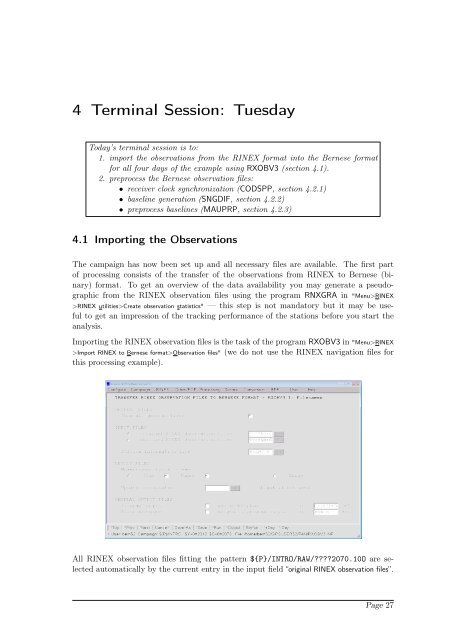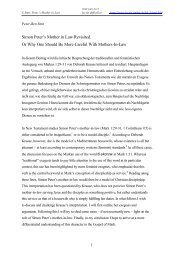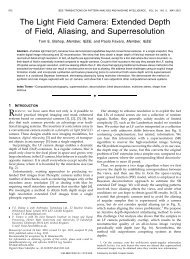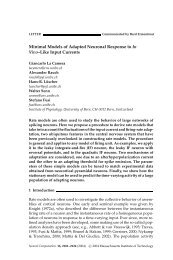- Page 1: Bernese GNSS SoftwareVersion 5.2Tut
- Page 6: 1 Introduction to the Example Campa
- Page 9 and 10: 1.2 Directory StructureSTAT_LOG :Th
- Page 11 and 12: 1.2 Directory StructureThe director
- Page 13 and 14: 1.2 Directory StructureClock RINEX
- Page 15 and 16: 2 Terminal Session: MondayToday’s
- Page 17 and 18: 2.4 Menu Variables>Configure>Menu v
- Page 19 and 20: 2.5 Generate A Priori CoordinatesIN
- Page 21: 3 Terminal Session: Pole and OrbitP
- Page 24 and 25: 3 Terminal Session: Pole and Orbit
- Page 26 and 27: 3 Terminal Session: Pole and Orbit
- Page 28 and 29: 3 Terminal Session: Pole and Orbit
- Page 32 and 33: 4 Terminal Session: TuesdayYou can
- Page 34 and 35: 4 Terminal Session: TuesdayTIME WIN
- Page 36 and 37: 4 Terminal Session: TuesdayWe alrea
- Page 38: 4 Terminal Session: Tuesday...*****
- Page 42: 4 Terminal Session: Tuesday4.2.3 Pr
- Page 46 and 47: 4 Terminal Session: TuesdayPage 42A
- Page 48 and 49: 5 Terminal Session: WednesdayThis r
- Page 50 and 51: 5 Terminal Session: WednesdayNo par
- Page 52 and 53: 5 Terminal Session: Wednesday...STA
- Page 54 and 55: 5 Terminal Session: WednesdayIn add
- Page 58 and 59: 5 Terminal Session: Wednesday...13.
- Page 60 and 61: 5 Terminal Session: WednesdayThe fi
- Page 62 and 63: 5 Terminal Session: WednesdayThe se
- Page 64 and 65: 5 Terminal Session: Wednesday...13.
- Page 66 and 67: 5 Terminal Session: WednesdayThe in
- Page 68 and 69: 5 Terminal Session: Wednesday5.3.2
- Page 70 and 71: 5 Terminal Session: WednesdayThe st
- Page 72 and 73: 5 Terminal Session: Wednesdayrate T
- Page 74 and 75: 5 Terminal Session: WednesdayIf you
- Page 76 and 77: 5 Terminal Session: WednesdayAll pr
- Page 78 and 79: 5 Terminal Session: WednesdayNote t
- Page 80 and 81:
6 Terminal Session: Thursdayday are
- Page 82 and 83:
6 Terminal Session: ThursdaySince t
- Page 84 and 85:
6 Terminal Session: ThursdayNUMBER
- Page 86 and 87:
6 Terminal Session: ThursdayIn the
- Page 88 and 89:
6 Terminal Session: Thursday...Stat
- Page 90 and 91:
6 Terminal Session: Thursday=======
- Page 92 and 93:
6 Terminal Session: ThursdayThe pro
- Page 94 and 95:
6 Terminal Session: ThursdayPlease
- Page 96 and 97:
6 Terminal Session: ThursdayThe nor
- Page 98 and 99:
6 Terminal Session: ThursdayFurther
- Page 100 and 101:
6 Terminal Session: ThursdayStatist
- Page 102 and 103:
6 Terminal Session: ThursdayWhen in
- Page 104 and 105:
6 Terminal Session: Thursday6.6 Dai
- Page 106 and 107:
7 Additional ExamplesThe messages##
- Page 108 and 109:
7 Additional ExamplesIt is importan
- Page 110 and 111:
7 Additional Examples6 96 0.003 0.0
- Page 112 and 113:
7 Additional ExamplesBecause the nu
- Page 114 and 115:
7 Additional ExamplesEnable the kin
- Page 116 and 117:
7 Additional ExamplesThe resulting
- Page 118 and 119:
7 Additional ExamplesThe default in
- Page 120 and 121:
7 Additional ExamplesFurthermore, y
- Page 122 and 123:
7 Additional ExamplesTake care to s
- Page 124 and 125:
7 Additional ExamplesClock paramete
- Page 126 and 127:
7 Additional ExamplesThe residuals
- Page 128 and 129:
7 Additional Examples7.3.3 Generate
- Page 130 and 131:
7 Additional ExamplesThe datum defi
- Page 132 and 133:
7 Additional ExamplesThe estimated
- Page 134 and 135:
7 Additional ExamplesThe clock solu
- Page 136 and 137:
7 Additional ExamplesThe table at t
- Page 138 and 139:
7 Additional ExamplesIn the second
- Page 140 and 141:
7 Additional ExamplesThe observatio
- Page 142 and 143:
7 Additional ExamplesNo constraints
- Page 144 and 145:
7 Additional ExamplesNo improvement
- Page 146 and 147:
7 Additional ExamplesThe resulting
- Page 148:
7 Additional ExamplesThe results ar
















